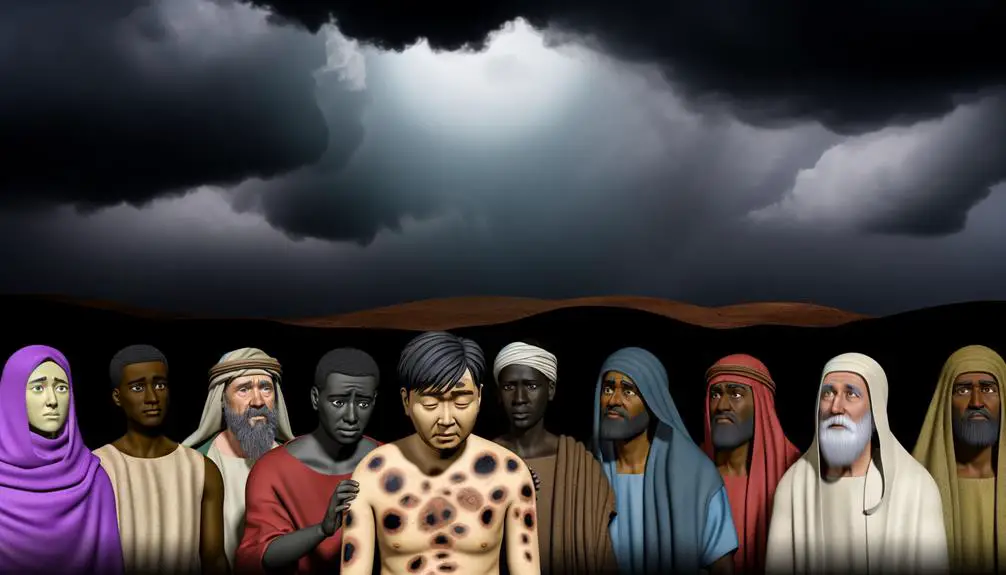Peek into biblical narratives to explore how epilepsy and spiritual healing intertwine, leaving room for modern reflection on faith and medicine.

Epileptics in the Bible
You might think the Bible skipped over modern medical diagnoses, but it seems the Good Book didn't shy away from discussing conditions like epilepsy—just not in the terms you're accustomed to. From the boy with seizures to Saul's tormented spirit, the narratives intertwine faith, healing, and what we might now label as neurological or psychological conditions.
Exploring these stories, you'll uncover a rich tapestry of interpretation and debate that not only sheds light on ancient understandings of health but also invites you to question how faith and medicine intersect in the lives of those deemed to be suffering from such afflictions.
So, what might these accounts reveal about the biblical perspective on health and spirituality?
Key Takeaways
- Biblical accounts, like the story of the boy with seizures, provide early references to epilepsy within a spiritual context.
- These narratives often blend medical conditions with divine interpretations, offering insights into ancient views on neurological disorders.
- Scholars propose conditions like epilepsy to explain certain biblical afflictions, such as Paul's "thorn in the flesh."
- Exploring these stories helps us understand historical perceptions of epilepsy and its societal and spiritual implications.
The Boy With Seizures

In the biblical account, a boy suffering from seizures presents a compelling case for the intersection of spirituality and health in ancient texts. This narrative, deeply rooted in historical context, offers a lens through which you can examine early medical understanding and societal reactions to neurological disorders. The description of the boy's condition, while not medically detailed by modern standards, aligns with what might now be recognized as epilepsy. This connection between ancient observations and contemporary medical terminology underscores the evolution of medical understanding over millennia.
The societal and spiritual interpretations of seizures during this era were significantly influenced by the prevailing historical context. Seizures, often misunderstood, were sometimes perceived as manifestations of supernatural or divine intervention. This perception wasn't unique to the biblical story but was a common theme across various cultures and religions of the time. The biblical account, therefore, not only reflects the medical understanding of the period but also illustrates the broader societal and spiritual implications of health conditions.
Analyzing this narrative through a scholarly lens, you're prompted to consider how ancient texts contribute to our understanding of historical medical practices and beliefs. The story of the boy with seizures invites you to reflect on the complexities of diagnosing and treating neurological disorders in an era before the advent of modern medicine. It also encourages a deeper appreciation for how cultural and spiritual beliefs have historically shaped responses to health challenges. Through this analytical exploration, you gain insights into the intricate web of spirituality, health, and society in ancient times, illuminating the enduring human quest to understand and cope with illness.
Saul's Tormented Spirit

You encounter Saul's mental distress as a multifaceted phenomenon within the biblical narrative, where it's often attributed to a tormented spirit.
This condition prompts scholars to explore both psychological and spiritual interpretations, considering the historical and cultural context of the times.
Such an analysis can illuminate the understanding of mental health and spiritual experiences in ancient texts, offering a nuanced perspective on Saul's experiences.
Saul's Mental Distress
Saul's mental distress, often depicted as a tormented spirit, reveals complex interactions between psychological, spiritual, and possibly physiological factors in his life. A psychological analysis suggests that the immense pressures of leadership significantly impacted his mental state. Leading a nascent nation, Saul faced extraordinary expectations and threats, both external and internal. These conditions likely exacerbated any pre-existing vulnerabilities to psychological distress.
The narrative of Saul's decline into erratic behavior and paranoia might reflect a profound struggle with these leadership-induced stresses. This analysis doesn't just illuminate Saul's personal ordeal but also offers insights into the broader implications of leadership on mental health. Understanding Saul's story through this lens highlights the timeless relevance of psychological support and awareness for leaders in high-stress roles.
Spiritual Interpretations Explored
Exploring the spiritual interpretations of Saul's tormented spirit reveals a complex tapestry of divine retribution, prophetic intervention, and ancient beliefs about mental health. The biblical narrative intertwines these elements, suggesting both a spiritual affliction and a divine test.
Aspect |
Biblical Context |
Relevance |
|---|---|---|
Divine Retribution |
Saul's disobedience |
Trigger for mental distress |
Prophetic Intervention |
David's harp playing |
Example of miraculous cures |
Ancient Beliefs |
Interpretation as possession |
Insight into historical accuracy |
This analysis sheds light on how miraculous cures and historical accuracy are woven into the fabric of Saul's story. The biblical account, while ancient, offers a multifaceted view on mental health issues, highlighting the interplay between spiritual beliefs and what we might now understand as psychological phenomena.
Paul's Thorn in the Flesh

You'll find that Paul's 'thorn in the flesh' has sparked diverse interpretations and theories regarding its nature, with some scholars proposing epilepsy as a plausible explanation. This analysis necessitates a careful examination of the text within its historical and cultural context, challenging traditional views and inviting a reconsideration of biblical afflictions.
Modern perspectives further enrich this discourse, offering new insights into understanding Paul's condition and its implications for his ministry and writings.
Paul's Affliction Theories
Various theories have emerged regarding Paul's 'thorn in the flesh,' a mysterious affliction mentioned in his epistles, suggesting it could range from physical ailments to spiritual struggles. Scholars have pondered whether this 'thorn' had practical implications on Paul's ability to fulfill his missionary journeys.
Travel implications, for instance, might've been significant, limiting the distances he could comfortably cover or the terrain he could traverse. Similarly, dietary restrictions could have been a necessity, impacting his health and energy levels. These theories aim to contextualize Paul's references, offering insight into how such an affliction could influence his daily life and ministry.
Through this lens, you gain a nuanced understanding of the challenges Paul might've faced, reflecting the broader human experience of navigating limitations while pursuing a purposeful life.
Biblical Interpretation Challenges
Interpreting Paul's 'thorn in the flesh' presents a complex challenge for biblical scholars. The ambiguous nature of this affliction leads to divergent understandings and interpretations. You're delving into a realm where historical context and translation accuracy are paramount.
The historical context provides clues about possible medical conditions prevalent at the time, enriching interpretations. However, the accuracy of translations plays a crucial role as well; slight nuances in ancient languages can significantly alter the meaning of texts. Scholars meticulously analyze these aspects, striving to bridge the gap between ancient and modern understandings.
This careful examination is essential, as it impacts how one perceives Paul's experiences and the broader theological implications. Understanding this complexity requires a balanced consideration of both historical context and translation accuracy.
Modern Perspectives Analyzed
Scholars have developed a range of interpretations regarding Paul's 'thorn in the flesh,' each reflecting different modern perspectives and analytical approaches. This debate highlights the complexity of applying contemporary medical knowledge to ancient texts. By examining the historical accuracy and implications of this biblical account, scholars aim to bridge the gap between past and present understandings of health conditions.
- Historical Context: Evaluating the text within its historical setting to understand the metaphorical and literal interpretations of Paul's condition.
- Medical Knowledge: Leveraging current medical insights to hypothesize about Paul's symptoms and possible diagnoses.
- Theological Implications: Considering how interpretations of Paul's thorn influence theological discussions and perceptions of physical ailments in religious contexts.
These perspectives offer a multifaceted view, enriching our understanding of biblical narratives through the lens of modern analysis.
The Healing of a Demon-Possessed Man

In the context of biblical narratives, the healing of a demon-possessed man demonstrates a profound intersection between faith, societal understanding of mental illness, and the divine power attributed to Jesus. This story, rich in cultural and theological layers, provides a unique lens through which to examine ancient perspectives on what we might now categorize under mental health disorders.
Aspect |
Analysis |
|---|---|
Demon identification |
In biblical times, behaviors we might now link to mental health issues were often attributed to demonic possession. This reflects a cultural context where spiritual explanations were predominant for phenomena not understood in medical or psychological terms. |
Cultural context |
The narrative occurs within a society deeply ingrained with religious beliefs. Miracles, such as the healing performed by Jesus, were seen as divine interventions that reinforced the spiritual authority of the healer. |
Faith and healing |
The act of healing in this story isn't just about alleviating physical or mental suffering; it's also about restoring faith and spiritual well-being, both for the individual and the community observing the miracle. |
Societal implications |
By addressing the demon-possessed man, Jesus challenged societal norms that often marginalized those deemed possessed. His actions promoted a message of inclusion and compassion. |
Modern interpretations |
Today, this story prompts discussions around the intersection of religion, mental health, and the societal labeling of mental illness. It encourages a reflective analysis of how cultural and spiritual beliefs shape our understanding of mental health. |
Exploring this narrative through a scholarly lens allows for a deeper understanding of how ancient societies navigated the complexities of human behavior and spiritual belief systems.
King Saul's Melancholy

Delving into the biblical account of King Saul, we observe a poignant depiction of melancholy that, through the lens of modern understanding, may resemble symptoms of depression. His story provides insight into the intersection of mental health, ancient treatments, and political implications within a biblical context.
Saul's distress is vividly documented, showing periods of profound sadness and erratic behavior. This condition significantly affected his reign and his relationships, most notably with David. The narrative suggests that Saul's mental state had direct political consequences, influencing his decision-making and leadership abilities.
Ancient treatments for such conditions were rudimentary and often intertwined with spiritual practices. Saul's remedy—music therapy provided by David's harp playing—highlights the early recognition of music's therapeutic effect on the mind. This intervention, though simplistic by today's standards, underscores the attempts to alleviate mental distress in ancient times.
The narrative of King Saul illustrates:
- The intertwining of spiritual and psychological interpretations of mental health issues in ancient texts.
- The political implications of a leader's mental health, affecting governance and leadership dynamics.
- Ancient treatments for mental health issues, emphasizing the limited but insightful approaches of the time.
Analyzing Saul's melancholy within the biblical framework offers a unique lens to explore the understanding and management of mental health in ancient times. It also provokes consideration of how mental health issues are perceived and treated in positions of power, a topic as relevant today as it was in Saul's time.
Nebuchadnezzar's Madness
Turning our attention to another biblical figure, we encounter the intriguing case of Nebuchadnezzar's madness, a narrative rich with psychological and theological dimensions. This story, chronicled in the Book of Daniel, describes how the Babylonian king is driven to insanity, living like an animal for seven years. This account raises questions about historical accuracy and the ancient treatments for such conditions.
Aspect |
Nebuchadnezzar's Madness |
Contextual Analysis |
|---|---|---|
Historical Basis |
Debated by scholars |
Reflects ancient views on mental health |
Ancient Treatments |
Not explicitly mentioned |
Suggests isolation, lack of intervention |
Theological Implications |
Punishment and restoration |
Highlights divine justice and mercy |
Modern Interpretation |
Metaphorical or literal |
Challenges in diagnosing ancient texts |
Analytically, this story's historical accuracy is debatable. Ancient texts often blend history with metaphor, making it challenging to discern literal events from illustrative teachings. However, the absence of detailed descriptions of ancient treatments for Nebuchadnezzar's condition does not diminish the narrative's value. Instead, it provides a window into how mental health conditions were perceived and, perhaps, managed or misunderstood in ancient times.
The theological underpinnings of this story are clear, portraying Nebuchadnezzar's madness as a divine punishment for his hubris and a subsequent restoration as a testament to divine mercy. This narrative invites readers to contemplate the intersections of divine justice, human vulnerability, and the potential for redemption.
Job's Afflictions

Exploring the story of Job, we uncover a profound narrative that scrutinizes the nature of suffering and divine testing through a series of devastating afflictions. This biblical account delves into the essence of human endurance in the face of unparalleled hardship. Job's ordeal begins with the loss of his wealth and children, swiftly followed by a severe physical ailment. Despite these calamities, Job's patience becomes a central theme, showcasing his unwavering faith amid dire circumstances.
The narrative of Job raises critical questions about divine justice and the purpose of suffering. Through Job's experiences, we're invited to reflect on the complexities of faith when confronted with life's inexplicable hardships. Job's patience isn't passive; it's an active struggle to maintain faith in divine justice despite overwhelming evidence to the contrary.
To understand Job's afflictions deeply, consider the following points:
- Job's Losses: Comprehensive, affecting his family, wealth, and health, testing his resilience and faith.
- Job's Physical Suffering: Described in vivid detail, his physical condition deteriorates, symbolizing the depth of his spiritual and emotional turmoil.
- Job's Response: His refusal to curse God, despite encouragement from his wife and the harsh judgments of his friends, highlights his extraordinary patience and commitment to uphold his integrity and faith in divine justice.
The story of Job, with its focus on Job's patience and the quest for understanding divine justice, offers an invaluable perspective on the enduring human spirit when faced with the inexplicable suffering.
The Role of Faith and Healing

One must consider the profound impact that faith and healing have, especially when viewed through the lens of biblical narratives. The scriptures are replete with instances where faith acts as a conduit for miraculous healings, often leaving scholars and theologians entrenched in miracle debates. These discussions not only scrutinize the veracity of such miracles but also delve into the faith dynamics at play.
Analyzing these biblical accounts, you'll find that faith isn't a mere passive belief but an active trust in divine power. This distinction is crucial in understanding the role of faith in the context of healing. The narratives often portray individuals whose faith leads them to seek healing, suggesting a dynamic interaction between human agency and divine intervention.
Moreover, the faith dynamics within these stories reveal a complex relationship between belief, doubt, and desperation. It's evident that faith, in these contexts, operates beyond the boundaries of a simple expectation of recovery. It encompasses a deeper spiritual engagement that challenges both the sufferers and the observers to reconsider their understanding of divine will and power.
In the midst of miracle debates, one mustn't lose sight of the central message these narratives convey about the nature of faith. It's portrayed not as a guarantee of healing but as a profound, sometimes testing, engagement with the divine. This perspective is vital for a scholarly, objective analysis of faith and healing within biblical accounts, offering insights into the enduring relevance of these themes in contemporary faith dynamics.
Frequently Asked Questions
How Has the Modern Interpretation of Epilepsy Changed the Understanding of These Biblical Accounts?
Modern diagnostics have vastly altered your understanding of conditions once seen through a spiritual lens. You now recognize symptoms described in ancient texts as epilepsy, not possession or divine punishment. This shift moves you away from spiritual interpretations towards a medical perspective, enriching your comprehension of historical accounts.
It enables you to view these narratives with a nuanced perspective, appreciating the evolution of medical knowledge and its impact on societal perceptions of epilepsy.
Are There Any Biblical Figures Traditionally Not Associated With Epilepsy Who Might Have Exhibited Symptoms When Analyzed Under Contemporary Medical Perspectives?
Peeling back the layers of history, you'll find that several figures might've exhibited epilepsy symptoms, especially when miraculous healings or visionary prophecies are considered.
Modern medical perspectives shed new light on these accounts, suggesting some individuals traditionally not linked to epilepsy could have been experiencing seizures.
This analytical, scholarly approach challenges you to rethink the narratives and understandings of these events, blending ancient texts with contemporary medical insights.
In What Ways Have These Stories Influenced Societal Perceptions and Treatment of Epilepsy Throughout History?
When examining how stories have shaped the treatment and perception of epilepsy, it's clear that medical stigma and religious interpretations played pivotal roles.
You'll find that historical attitudes towards epilepsy were often influenced by misconceptions, leading to widespread stigma.
Moreover, religious interpretations sometimes compounded this, either by attributing seizures to divine or demonic sources.
This intertwined relationship between medicine and religion significantly affected societal views and the care of individuals with epilepsy.
How Do Different Translations of the Bible Affect the Interpretation of These Episodes as Related to Epilepsy or Seizures?
You'll find that translation consistency and linguistic evolution dramatically shape your understanding of historical texts. Considering how different Bible translations affect interpretations, it's important to recognize that words evolve, and so does their impact.
This evolution can alter perceptions significantly, especially in contexts like medical conditions. Analyzing these translations reveals how language shifts influence societal interpretations, underscoring the critical role of linguistic precision in conveying historical narratives and their implications accurately.
What Role Do Cultural and Historical Contexts Play in Distinguishing Between Spiritual Experiences and Medical Conditions Like Epilepsy in Biblical Narratives?
When examining narratives, you'll find that cultural and historical contexts significantly shape how spiritual experiences and medical conditions, like epilepsy, are distinguished.
Your ability to perform spiritual discernment and apply historical diagnostics hinges on understanding these nuances.
These contexts provide a lens through which you can critically analyze texts, discerning between what's considered a divine encounter and what's recognized as a medical condition within that time period.
Conclusion
In navigating the biblical seas, you've glimpsed the tempests of the mind and spirit that afflicted figures from the shores of antiquity. These narratives, veiled in divine metaphor and human struggle, aren't just ancient texts but mirrors reflecting the perennial battle with mental and physical tempests.
Your journey underscores the immutable human quest for solace and healing, where faith serves as both anchor and compass. It's a testament to our shared voyage through the stormy waters of existence, seeking the lighthouse of understanding and relief.



Sign up